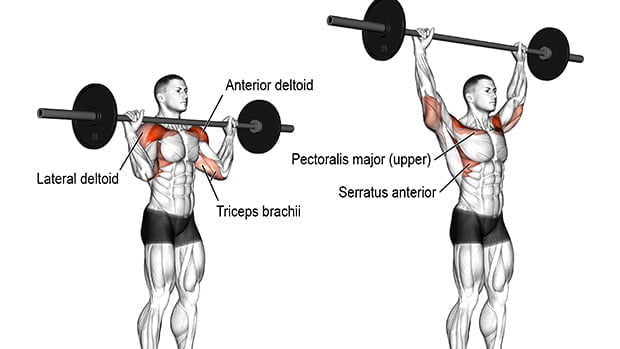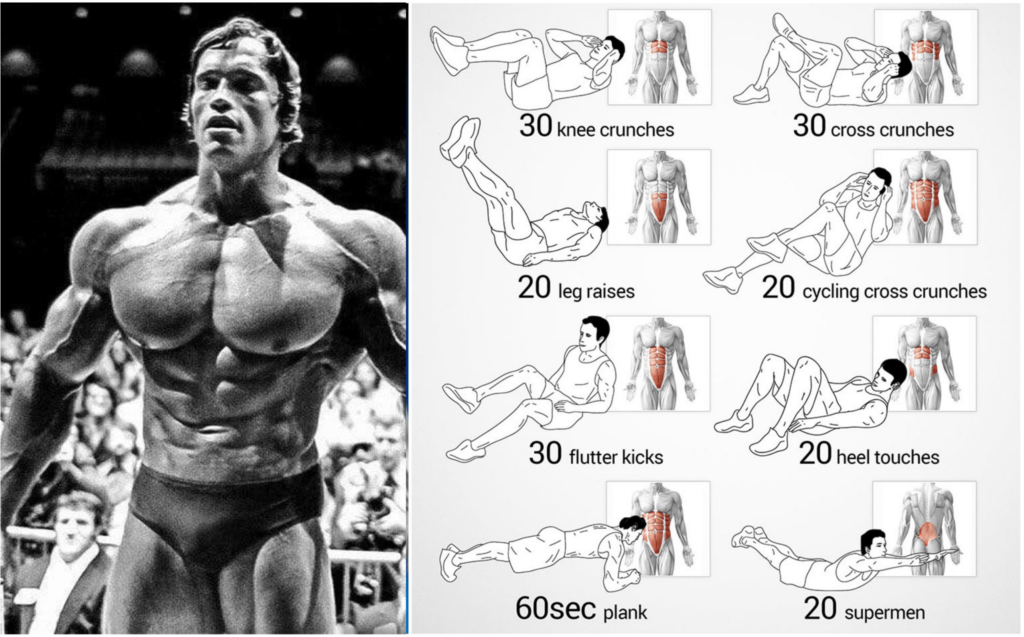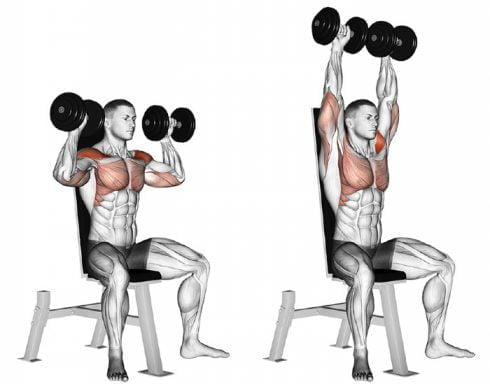Introduction
Compound exercises are exercises that engage multiple muscle groups at the same time, such as squats, deadlifts, bench press, pull-ups, and rows. These exercises are different from isolation exercises, which target only one specific muscle group at a time, such as bicep curls or leg extensions.
Compound exercises are important for building muscle mass because they allow you to lift heavier weights and work more muscles simultaneously, leading to greater muscle activation and hypertrophy (i.e., muscle growth). Additionally, compound exercises can improve overall strength, power, and athleticism, making them a valuable addition to any workout routine.
The purpose of this article is to explore the question of whether it is possible to build muscle with just compound exercises. We will examine the benefits and limitations of using only compound exercises for muscle building, and discuss the role of compound exercises in a balanced workout routine that includes both compound and isolation exercises. By the end of this article, you should have a better understanding of the importance of compound exercises for muscle building and how to incorporate them into your workout routine for maximum results.
What Are Compound Exercises?

Compound exercises are multi-joint movements that involve the use of multiple muscle groups simultaneously. These exercises are considered to be highly effective for building muscle mass and strength, as they allow for heavier weights to be lifted and can stimulate the growth of multiple muscle groups at once.
Some of the benefits of compound exercises for building muscle mass include:
- Increased muscle activation: Because compound exercises involve multiple muscle groups working together, they can activate more muscle fibers than isolation exercises, leading to greater muscle growth and strength gains.
- Increased calorie burn: Compound exercises typically require more energy and effort to perform than isolation exercises, which can lead to a higher calorie burn during and after workouts.
- Improved functional fitness: Compound exercises mimic movements that we use in everyday life, making them effective for improving overall strength, stability, and mobility.
Some examples of common compound exercises include:
- Squats: Squats is a multi-joint exercise that involves the use of the hips, knees, and ankles, and work the muscles of the legs, glutes, and core.
- Deadlifts: Deadlift is a multi-joint exercise that involves the use of the hips, knees, and back, and work the muscles of the legs, back, and core.
- Bench press: The bench press is a multi-joint exercise that involves the use of the chest, shoulders, and triceps, and can help build upper body strength and muscle mass.
- Pull-ups: Pull-up is a multi-joint exercise that involves the use of the back, arms, and core, and can help build upper body strength and muscle mass.
Overall, compound exercises are a highly effective way to build muscle mass and strength, and should be included in any well-rounded workout routine.
How Do Compound Exercises Build Muscle?

Compound exercises are multi-joint movements that require the activation of multiple muscle groups, including both primary and secondary muscles. The activation of multiple muscle groups leads to an increase in the amount of weight that can be lifted, which leads to greater muscle fiber recruitment and mechanical tension on the muscles.
This mechanical tension is the primary stimulus for muscle growth, as it creates microtears in the muscle fibers that then repair and grow back stronger and larger. The increased demand on the cardiovascular system during compound exercises also leads to an increase in blood flow and nutrient delivery to the muscles, which can further support muscle growth.
- Engagement of multiple muscle groups simultaneously
Additionally, compound exercises engage multiple muscle groups simultaneously, which allows for more efficient and effective muscle building compared to isolation exercises. For example, a squat not only targets the quadriceps but also engages the glutes, hamstrings, and core muscles. This simultaneous engagement of multiple muscle groups leads to a greater overall demand on the body, which can stimulate more muscle growth.
- Comparison of muscle activation and hypertrophy effects of compound exercises versus isolation exercises
Research has shown that compound exercises are more effective than isolation exercises for activating muscle fibers and promoting muscle hypertrophy. One study found that the squat and deadlift activated more muscle fibers in the lower body than any other exercise, including isolation exercises like leg curls and leg extensions. Another study found that compound exercises led to greater increases in muscle size and strength compared to isolation exercises in trained individuals. However, it’s important to note that isolation exercises can still be useful for targeting specific muscle groups and addressing muscle imbalances.
In summary, compound exercises are highly effective for building muscle mass and promoting muscle hypertrophy due to the engagement of multiple muscle groups and the resulting increase in mechanical tension on the muscles. While isolation exercises can be useful for targeting specific muscle groups, compound exercises should be the foundation of any muscle-building workout routine.
Advantages of Using Only Compound Exercises for Muscle Building
Compound exercises, which involve multiple muscle groups and joints, have been shown to be highly effective for building muscle mass, increasing strength and power, and improving overall fitness. Some people choose to use only compound exercises in their workout routines, citing the numerous benefits and time efficiency of these exercises.

Research studies have shown that using only compound exercises can produce significant gains in muscle mass and strength compared to using a combination of compound and isolation exercises. One study published in the Journal of Strength and Conditioning Research found that a compound exercise-only training program led to greater increases in lean body mass and total strength than a program that included both compound and isolation exercises.
Benefits of using only compound exercises
One of the main advantages of using only compound exercises for muscle building is that they engage multiple muscle groups simultaneously, allowing for greater muscle activation and hypertrophy. This results in more overall muscle growth and increased strength, as the body becomes better equipped to handle heavier loads.
Another advantage of using only compound exercises is their time efficiency. Compound exercises allow individuals to work multiple muscle groups at once, reducing the amount of time needed to complete a full-body workout. This can be especially beneficial for individuals with busy schedules who may not have as much time to devote to their fitness routines.
When it comes to building lean muscle, compound exercises are highly effective. They stimulate the body to produce more testosterone and growth hormone, both of which are essential for muscle growth and hypertrophy. In addition, compound exercises help to improve overall muscle definition and tone by burning fat and improving muscle endurance.
While there are many advantages to using only compound exercises for muscle building, there are also some limitations to consider. One potential drawback is that compound exercises may not target specific muscle groups as effectively as isolation exercises. This can result in imbalanced muscle development if certain muscle groups are neglected. Another potential limitation is the risk of injury, as compound exercises can be more challenging and require proper form and technique to be performed safely.
In conclusion, using only compound exercises for muscle building can be highly effective, resulting in increased muscle mass, strength, and power, as well as improved overall fitness. However, it is important to consider the potential limitations and to incorporate a balanced workout routine that includes both compound and isolation exercises for optimal results.
Limitations of Using Only Compound Exercises for Muscle Building
Using only compound exercises for muscle building has its limitations, which include:
- Imbalanced muscle development: Compound exercises engage multiple muscle groups simultaneously, but they may not target specific muscles as effectively as isolation exercises. This can lead to imbalanced muscle development, where certain muscles are overdeveloped while others are neglected.
- Lack of specific muscle targeting: Compound exercises are effective at building overall muscle mass and strength, but they may not be as effective at targeting specific muscles. This can be a disadvantage for individuals who want to focus on developing certain muscle groups.
- Higher risk of injury: Because compound exercises engage multiple muscle groups and involve more complex movements, there is a higher risk of injury if proper form and technique are not used. This can be especially true for beginners who are not yet familiar with proper lifting techniques.
- Inability to isolate weak muscles: If you have weak or underdeveloped muscles, compound exercises may not be the best way to target them. Because compound exercises engage multiple muscle groups at once, it can be difficult to isolate and target a specific muscle that needs extra attention.
- Plateau in muscle growth: While compound exercises are great for building strength and muscle mass, your body may eventually adapt to the stress placed on it, resulting in a plateau in muscle growth. Incorporating isolation exercises or changing up your workout routine can help to prevent this plateau and continue to stimulate muscle growth.
- Risk of overtraining: Because compound exercises engage multiple muscle groups, they can be more taxing on your body than isolation exercises. Overtraining can lead to fatigue, injury, and decreased muscle growth. It is important to balance your workout routine with proper rest and recovery time to prevent overtraining.
To minimize the limitations of using only compound exercises for muscle building, it is important to focus on proper form and technique. This includes:
- Using proper lifting technique: Ensuring proper lifting technique for compound exercises is essential to prevent injury and maximize muscle growth. This includes maintaining proper posture, keeping your core engaged, and using a controlled, steady lifting motion.
- Starting with lighter weights: Starting with lighter weights and gradually increasing the weight can help to ensure that you are using the proper form and technique, as well as minimizing the risk of injury.
- Incorporating isolation exercises: Including isolation exercises in your workout routine can help to target specific muscle groups and prevent imbalanced muscle development. This can include exercises such as bicep curls, tricep extensions, and leg curls.
- Varying your workout routine: Incorporating a variety of exercises, both compound and isolation, can help to prevent boredom, increase motivation, and ensure a well-rounded workout routine that targets all muscle groups.
In conclusion, while compound exercises are effective at building overall muscle mass and strength, they have limitations when used exclusively. To maximize muscle growth and minimize the risk of injury, it is important to focus on proper form and technique, incorporate isolation exercises, and vary your workout routine.
Tips for Using Compound Exercises to Build Muscle
Compound exercises are an effective way to build muscle mass, strength, and power. However, to get the most out of compound exercises, it’s important to use proper form, appropriate weights and reps, and to prioritize rest and recovery.
One of the best practices for incorporating compound exercises into a muscle-building workout routine is to start with the big lifts that target multiple muscle groups. Examples of compound exercises include squats, deadlifts, bench presses, pull-ups, and rows. These exercises should be performed at the beginning of the workout when you are fresh and have the most energy.

When selecting appropriate weights for compound exercises, it’s important to choose a weight that is challenging but still allows you to maintain proper form throughout the exercise. A weight that is too heavy can compromise form, increase the risk of injury, and reduce the effectiveness of the exercise. Conversely, a weight that is too light may not provide enough stimulus for muscle growth. Repetition ranges can vary based on the individual’s goals and fitness level, but typically a range of 8-12 reps per set is recommended for muscle hypertrophy.
Rest and recovery are critical components of muscle-building, and are especially important when using compound exercises. Adequate rest between sets and workouts is essential to allow the muscles to recover and repair. It’s important to schedule rest days into your workout routine to avoid overtraining, which can lead to injury and stalled progress.
In summary, compound exercises are a powerful tool for building muscle mass and strength. To use them effectively, it’s important to start with the big lifts, choose appropriate weights and reps, and prioritize rest and recovery. Incorporating compound exercises into a balanced workout routine that includes both compound and isolation exercises can help maximize muscle-building results.
Compound Exercises for Different Muscle Groups
Compound exercises are a popular and effective way to build muscle mass and improve overall fitness. They are exercises that engage multiple muscle groups at the same time, often involving movements that are more complex and require more coordination than isolation exercises that target a single muscle. Using compound exercises to target different muscle groups can lead to better muscle hypertrophy, increased strength, and more efficient workouts.

Here’s an overview of compound exercises that target different muscle groups:
- Chest: Compound exercises that target the chest include bench press, push-ups, and dips. These exercises engage the chest muscles as well as the triceps and shoulders, resulting in better overall upper body strength and muscle mass.
- Back: Compound exercises that target the back include pull-ups, rows, and lat pull-downs. These exercises work the muscles of the upper and lower back, as well as the biceps and shoulders, leading to better posture, increased strength, and improved overall fitness.
- Legs: Compound exercises that target the legs include squats, lunges, and deadlifts. These exercises engage the muscles of the legs and glutes, as well as the lower back and core, leading to better overall lower body strength, improved balance, and increased muscle mass.
- Shoulders: Compound exercises that target the shoulders include overhead presses, lateral raises, and upright rows. These exercises engage the muscles of the shoulders, triceps, and upper back, leading to better overall upper body strength and improved posture.
- Arms: Compound exercises that target the arms include pull-ups, push-ups, dips, and chin-ups. These exercises work the biceps and triceps, as well as the shoulders and chest, leading to better overall upper body strength and improved muscle definition.
Using compound exercises that target multiple muscle groups has several benefits compared to isolation exercises that focus on a single muscle group. First, compound exercises can help you save time in the gym because they allow you to work multiple muscle groups at once, leading to more efficient workouts. Second, compound exercises tend to lead to better overall muscle hypertrophy and strength gains compared to isolation exercises. Finally, compound exercises can help improve overall functional fitness by simulating movements that are used in everyday activities.
In conclusion, using compound exercises to target different muscle groups is an effective way to build muscle mass and improve overall fitness. Incorporating compound exercises into your workout routine can help you achieve your fitness goals more efficiently and effectively.
Compound Exercises for Different Fitness Levels
Compound exercises are an excellent way to build muscle mass and promote overall strength and fitness. However, it’s important to recognize that different individuals have different fitness levels, and the exercises that may be appropriate for one person may not be suitable for another. Therefore, it’s crucial to understand how to adapt compound exercises to meet the needs of different fitness levels.
For beginners, compound exercises can be modified to ensure proper form and prevent injury. When starting out, it’s important to use light weights and focus on learning the proper technique for each exercise. This will help to prevent muscle strain and ensure that the exercise is effective. Additionally, beginners can start by performing fewer reps and sets to allow their muscles to adapt to the exercise gradually.
For intermediate fitness levels, adjustments to compound exercises can be made to increase the intensity and promote muscle growth. This can include using heavier weights or performing more reps and sets. Intermediate fitness levels can also incorporate more challenging variations of compound exercises, such as using resistance bands or incorporating plyometrics.
For advanced fitness levels, compound exercises can be modified to provide an intense workout and promote continued muscle growth. This can include using very heavy weights or performing compound exercises in a superset or circuit format to increase the overall intensity of the workout. Advanced fitness levels can also incorporate more advanced variations of compound exercises, such as using unstable surfaces or performing exercises explosively.
It’s important to note that, regardless of fitness level, proper form and technique should always be the top priority when performing compound exercises. Adjusting the weights, reps, and sets can provide additional challenges and promote muscle growth, but it’s crucial to do so safely and without risking injury.
In summary, compound exercises can be modified to meet the needs of different fitness levels, from beginners to advanced athletes. Modifications can be made to increase or decrease the intensity of the workout, such as adjusting weights or reps. Regardless of fitness level, proper form and technique should always be prioritized to prevent injury and ensure the exercise is effective.
Conclusion
In conclusion, we have explored the role of compound exercises in building muscle mass and achieving fitness goals. Compound exercises are a highly effective way to build muscle due to their ability to engage multiple muscle groups simultaneously. This leads to increased muscle activation, greater muscle hypertrophy, and improved overall strength and power.
Using only compound exercises for muscle building can be advantageous for some individuals, as it allows for a more efficient workout routine and can lead to impressive muscle mass development. However, it is important to keep in mind that using only compound exercises may not be suitable for everyone, as it can lead to imbalanced muscle development and a higher risk of injury.
To maximize the benefits of compound exercises and achieve the best possible results, it is important to include a variety of exercises in your workout routine, including both compound and isolation exercises. Additionally, proper form and technique should always be prioritized to prevent injury and ensure optimal muscle activation.
Overall, compound exercises are a valuable tool for anyone looking to build muscle and improve their fitness. By incorporating these exercises into your workout routine and following best practices for safe and effective training, you can achieve your muscle-building goals and enjoy improved overall health and wellness.
If you’ve found our content helpful, please consider supporting our efforts to create more valuable resources by making a donation today. Your contribution helps us continue to provide high-quality, informative content to our readers. DONATE HERE

Good day, and welcome to Fitthour. My name is Shubham Vijay, and I am a certified personal trainer and nutrition coach with 6 years of experience in the fitness industry. At Fitthour, we specialize in types of training, such as strength training, cardio, or HIIT, and our mission is to help clients achieve their fitness goals and improve their overall health.




